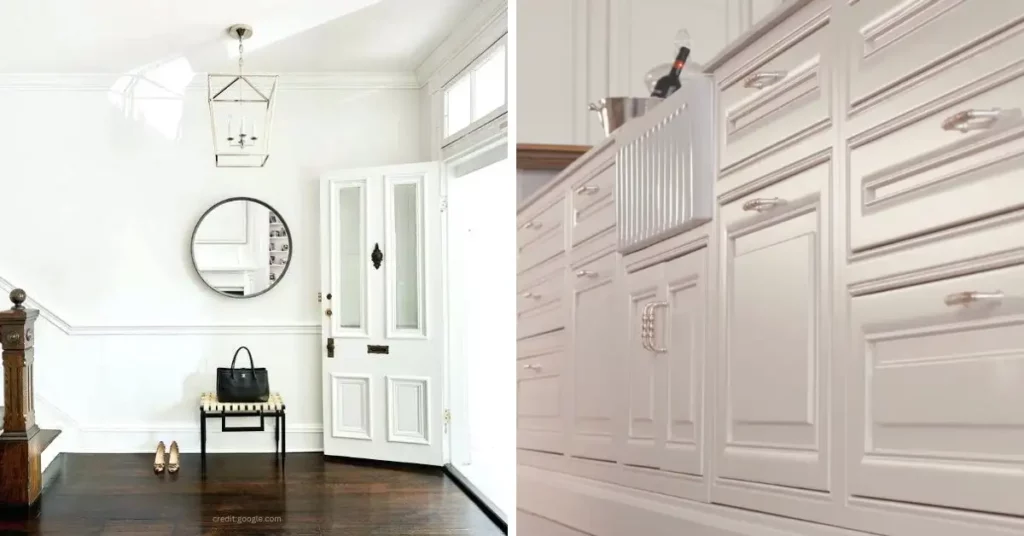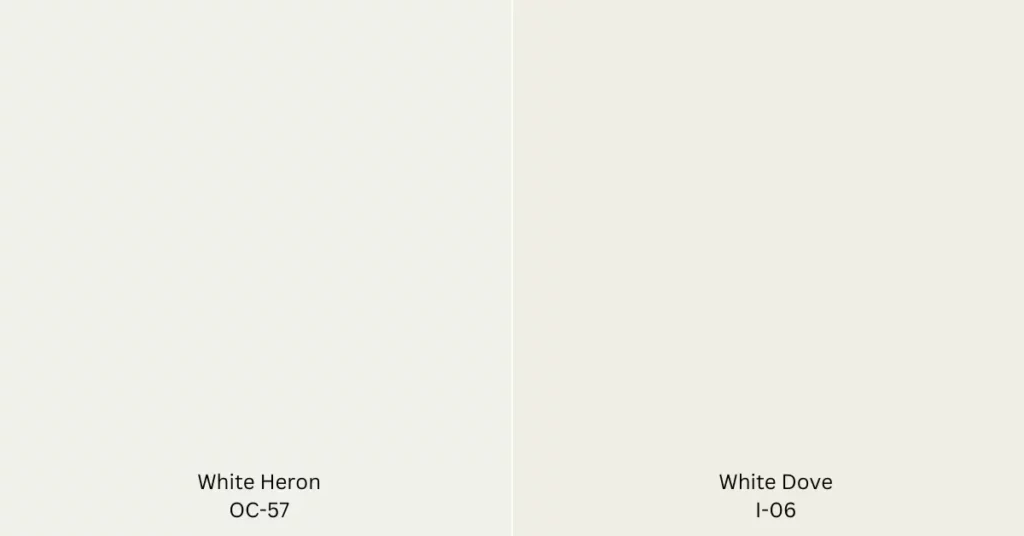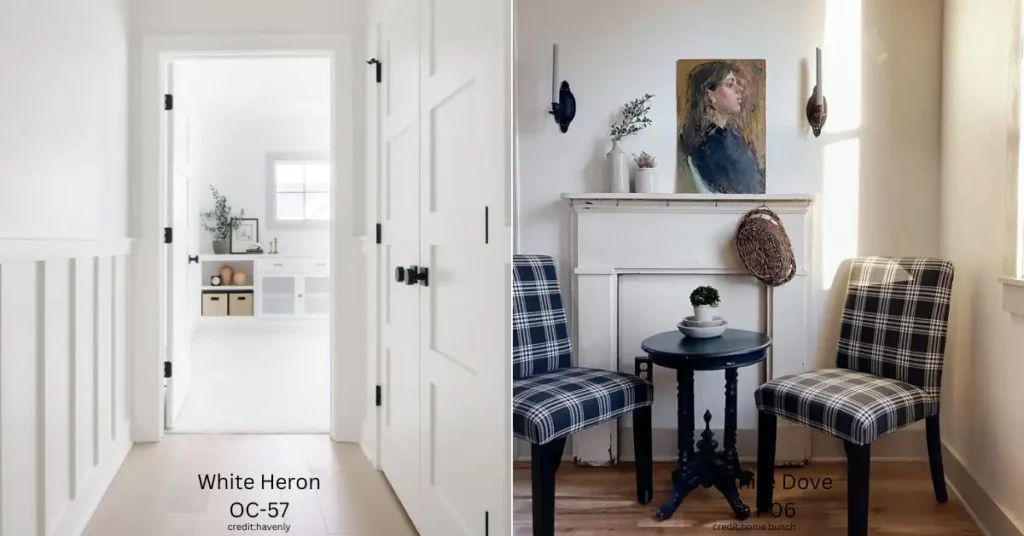Are you struggling to choose between Benjamin Moore’s classic White Heron and White Dove paint options? These popular shades are neutral and classic, making them ideal options for any interior design project.
But, these two shades have some key differences when it comes to undertones, hue, reflectivity, versatility, trim color, warmth, texture, lightness, undertone consistency, and sheen. And depending on the look and feel you want to achieve for your space, one option may be a better fit.

Here, we’ll dive into the details of Benjamin Moore White Heron vs White Dove, so you can confidently choose the perfect shade for your space.
The Differences Between Benjamin Moore White Heron vs White Dove
Benjamin Moore, a trusted brand in the paint industry, offers two popular whites: White Heron and White Dove. While they may seem similar at first glance, these shades have distinct differences that can significantly impact the overall look and feel of your space.
Undertones
Benjamin Moore White Heron boasts warm undertones that lean towards yellow, contributing to its cozy and inviting vibe. Conversely, Benjamin Moore White Dove showcases cool undertones with a subtle touch of gray, evoking a more refined and elegant ambiance. You can also look for Benjamin Moore Thunder vs Revere Pewter.

These undertones impact how the colors interact with lighting and other colors in a space.
Hue
White Heron is a true white, meaning it has no additional color pigments added to it. On the other hand, Benjamin Moore White Dove has a creamy off-white hue, attributed to small amounts of warm beige pigments blended into the color. This slight variation can create a more muted and softer effect on walls.
Reflectivity
Benjamin Moore White Heron has a lower reflectivity level than White Dove, enabling it to be utilized in spaces with lots of natural light. This works well because darker, reflective paints can appear more intense and overpowering in bright surroundings.
White Dove’s higher reflectivity lends itself to a luminous, bright look on walls with adequate lighting.
Lightness
White Heron is slightly lighter than White Dove, giving it a brighter and airier appearance. This makes it perfect for small or cramped rooms that need a light and open feel.
Versatility
White Dove is generally more versatile than White Heron, given its ability to coordinate effortlessly with an extensive range of interior styles and accent colors. It can be the perfect backdrop to both traditional and contemporary decor.
Benjamin Moore White Heron’s warm undertones make it ideal for cozy, warm spaces but can be less adaptable to other design styles.
Trim Color
White Heron’s warmer undertones lend themselves better as a trim color, often creating an eye-catching contrast with the cooler colors on walls. In contrast, White Dove’s slightly creamy hue can make it a more subdued option for accents or trim work.
Undertone Consistency
Benjamin Moore While White Dove has a consistent undertone that shows well even in different lighting conditions, the undertones in Benjamin Moore White Heron may vary depending on the type or amount of lighting present in the area.
Warmth
In terms of warmth, White Heron has a more inviting feel than White Dove, which can appear cooler and more formal. Choosing between these two colors to create a desired ambiance in space involves considering the psychological and design impact of the space.
Texture
White Heron’s warm undertones can help highlight texture and architectural details in walls, making it ideal for creating interest and dimensionality.

In contrast, White Dove has a smoother, more uniform appearance, which can blend into the background and create a more understated aesthetic.
Sheen
Benjamin Moore White Heron is typically used in a matte or eggshell sheen, creating a low-sheen appearance that can mask minor imperfections on walls.
Meanwhile, Benjamin Moore White Dove works well in a more extensive range of sheens, including semi-gloss and high gloss, providing a more lustrous surface with better ease of cleaning.
Comparison Table of Benjamin Moore White Heron vs White Dove:
| Feature | Benjamin Moore White Heron | Benjamin Moore White Dove |
| Undertones | Warm with a slight hint of yellow | Cool with a touch of gray |
| Hue | True white | Creamy off-white |
| Reflectivity | Less reflective, suitable for rooms with natural light | More reflective |
| Lightness | Slightly lighter, giving it a brighter appearance | Slightly darker |
| Versatility | Less versatile, limited accent color and decor style | More versatile, works well with a wider range of styles and colors |
| Trim Color | Suitable for trim | Better suited for walls |
| Undertone consistency | Can look different depending on the lighting | More consistent undertone in various lighting conditions |
| Warmth | Warmer and inviting feel | Cooler and more formal |
| Texture | Helps highlight texture and architectural details | Smoother and more uniform appearance |
| Sheen | Often used in matte or eggshell sheen | Works in a wider range of sheens, including semi-gloss and high gloss |
Explore the Timeless Elegance of Benjamin Moore’s White Heron and White Dove
When it comes down to it, choosing between Benjamin Moore’s White Heron and White Dove comes down to a matter of preference and your specific design needs.
If you want to create a warmer, cozier space, White Heron may be a perfect choice. On the other hand, if you’re searching for a cool, crisp shade that works well with various trim colors, White Dove could be the way to go.
Regardless of shade, White Heron and White Dove are classic and timeless options that will never go out of style.

S. Pushon is a paint expert, self-taught artist, and currently working as an adviser in the paint industry as a Quality Improvement and Development Assistant.
An artist by heart, he draws remarkable art pieces and as a professional paint industry individual, he seeks the insight and shares with enthusiasts. Read more…

